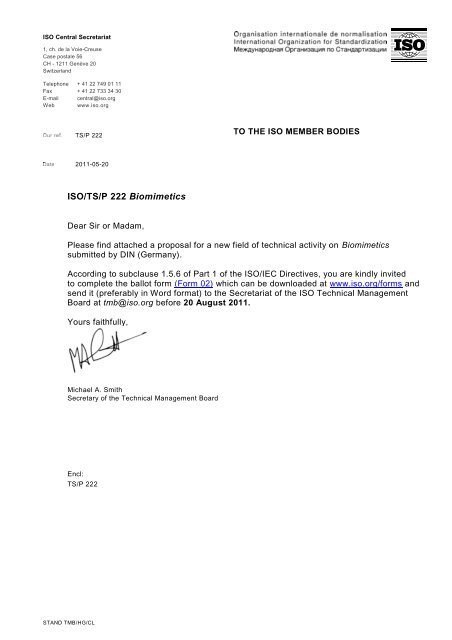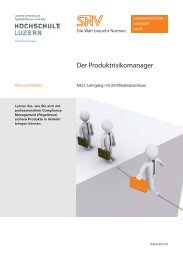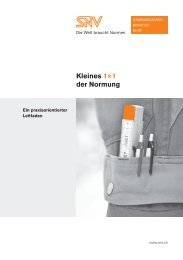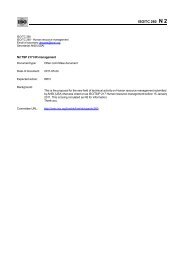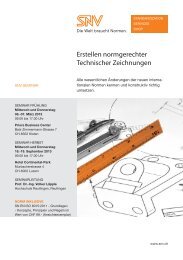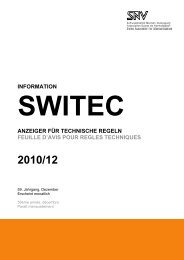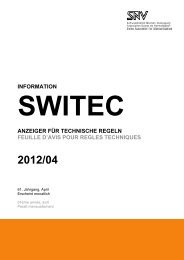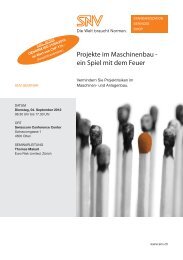ISO/TS/P 222 Biomimetics - SNV
ISO/TS/P 222 Biomimetics - SNV
ISO/TS/P 222 Biomimetics - SNV
Create successful ePaper yourself
Turn your PDF publications into a flip-book with our unique Google optimized e-Paper software.
<strong>ISO</strong> Central Secretariat<br />
1, ch. de la Voie-Creuse<br />
Case postale 56<br />
CH - 1211 Genève 20<br />
Switzerland<br />
Telephone + 41 22 749 01 11<br />
Fax + 41 22 733 34 30<br />
E-mail central@iso.org<br />
Web www.iso.org<br />
<strong>TS</strong>/P <strong>222</strong><br />
TO THE <strong>ISO</strong> MEMBER BODIES<br />
2011-05-20<br />
<strong>ISO</strong>/<strong>TS</strong>/P <strong>222</strong> <strong>Biomimetics</strong><br />
Dear Sir or Madam,<br />
Please find attached a proposal for a new field of technical activity on <strong>Biomimetics</strong><br />
submitted by DIN (Germany).<br />
According to subclause 1.5.6 of Part 1 of the <strong>ISO</strong>/IEC Directives, you are kindly invited<br />
to complete the ballot form (Form 02) which can be downloaded at www.iso.org/forms and<br />
send it (preferably in Word format) to the Secretariat of the <strong>ISO</strong> Technical Management<br />
Board at tmb@iso.org before 20 August 2011.<br />
Yours faithfully,<br />
Michael A. Smith<br />
Secretary of the Technical Management Board<br />
Encl:<br />
<strong>TS</strong>/P <strong>222</strong><br />
STAND TMB/HG/CL
PROPOSAL FOR A NEW FIELD OF TECHNICAL ACTIVITY<br />
Date of proposal<br />
2011-05-16<br />
Proposer<br />
DIN-Germany<br />
Reference number<br />
(to be given by Central Secretariat)<br />
<strong>ISO</strong>/<strong>TS</strong>/P <strong>222</strong><br />
A proposal for a new field of technical activity shall be submitted to the Central Secretariat, which will assign it a reference<br />
number and process the proposal in accordance with the <strong>ISO</strong>/IEC Directives (part 1, subclause 1.5). The proposer may be a<br />
member body of <strong>ISO</strong>, a technical committee or subcommittee, the Technical Management Board or a General Assembly<br />
committee, the Secretary-General, a body responsible for managing a certification system operating under the auspices of <strong>ISO</strong>,<br />
or another international organization with national body membership. Guidelines for proposing and justifying a new field of<br />
technical activity are given in the <strong>ISO</strong>/IEC Directives (part 1, annex Q).<br />
The proposal (to be completed by the proposer)<br />
Subject (the subject shall be described unambiguously and as concisely as possible)<br />
<strong>Biomimetics</strong><br />
Scope (the scope shall define precisely the limits of the proposed new field of activity and shall begin with<br />
"Standardization of ..." or "Standardization in the field of ...")<br />
Standardization in the field of biomimetics. The proposed <strong>ISO</strong>/TC will be<br />
responsible for the international standardization of biomimetic methods and<br />
approaches, incorporating the most recent results of R&D projects.<br />
"<strong>Biomimetics</strong>" (also "bionics", "biomimicry") is to be classified and defined, and<br />
a terminology developed. The limits and potentials of biomimetics as an<br />
innovation system or a sustainability strategy are to be explored.<br />
The entire biomimetic process ranging from the development of ideas to the<br />
creation of bionic products is to be described and standardized.<br />
Purpose and justification (the justification shall endeavour to assess the economic and social advantages which would<br />
result from the adoption of International Standards in the proposed new field)<br />
Bio-inspired materials and design are becoming of increasing interest in many<br />
fields of practical applications. In contrast to man-made materials, natural<br />
materials such as wood, bone and shells are composed of only a limited number of<br />
basic components. They gain their diversity in mechanical properties by<br />
hierarchical structuring which allows them to fulfill a variety of functions e.g.<br />
self-healing, mechanical stability, high toughness.<br />
As a result of quickly advancing physical characterization techniques, knowledge<br />
about hierarchical structures has increased significantly in recent years and<br />
form-function relationships are being unveiled. But combining the knowledge of<br />
natural materials with modern techniques of simulation and fabrication is still<br />
the exception, also due to the lack of communication between bio- and material<br />
scientists.<br />
The proposed standardization activities will make interdisciplinary work<br />
possible. The aim is the efficient translation of research results into technical<br />
products along the entire value chain through the close cooperation of<br />
biologists, engineers and experts from other disciplines. The realization of<br />
bionic ideas relies on the successful abstraction of biological principles and<br />
the transfer into technology. The successful transfer of knowledge about the<br />
structures, processes and characteristics of living beings to technical systems<br />
requires clear communication, correspondence and transparency between disciplines<br />
. Standards can make a major contribution to laying these foundations. By<br />
standardizing terms and definitions on a global level a common language will be<br />
established. International cooperation common in biomimetic projects will<br />
therefore be greatly simplified.<br />
So far <strong>Biomimetics</strong> has not been standardized on International level (<strong>ISO</strong>) and/or<br />
on European level (CEN). This is partly due to the fact that <strong>Biomimetics</strong> are<br />
interdisciplinary.<br />
FORM 1 (<strong>ISO</strong>)<br />
Version/V2007.1<br />
See overleaf
Purpose and justification (continued)<br />
Because of this versatility it is barely possible to focus Standardization<br />
activities only on one already existing <strong>ISO</strong>/TC of numerous possible <strong>ISO</strong>/TC's. And<br />
even if <strong>Biomimetics</strong> would be standardized in one of the existing <strong>ISO</strong>/TC's the<br />
scope of this certain <strong>ISO</strong>/TC would only cover a part of it.<br />
This exposes the intension of the proposer to establish a new <strong>ISO</strong>/TC<br />
"<strong>Biomimetics</strong>".<br />
The main motivation for transferring biological solutions to technical<br />
applications lies in the fact that optimized biological structures which have<br />
evolved over a period of 3,8 billion years can also be significant for<br />
technological developments. Today over 2,5 million distinct species have been<br />
identified, a gigantic pool of ideas for applying bionics to technical solutions.<br />
There are various examples of ideas that can be used as basic approach for<br />
standardization efforts.<br />
A method for developing surface structures for reducing frictional resistance in<br />
connection with methods for developing self-cleaning surface structures, e.g. for<br />
the hulls of ships and aircraft, could be covered. There are over 200 patents<br />
dealing with the "Lotus-Effect®" and numerous practical applications include<br />
self-cleaning exterior paints, plasters, and roof tiles. In plastics moulding<br />
processes the effect is used for injection moulding parts with self-cleaning<br />
surfaces.<br />
Another example are biomimetic methods considering cutting tools. To ensure that<br />
conventional cutting tools remain constantly sharp, material wear must be<br />
minimized. However, teeth of rodents remain sharp through a constant selfsharpening<br />
process by wearing of two different materials which results in a sharp<br />
edge. This principle was used to develop self-sharpening cutting tools.<br />
Biological models for lightweight construction and other structures include<br />
winter horsetail (Equisetum hyemale) and the giant reed (Arundo donax). A<br />
recently developed material combines the various principles of the winter<br />
horsetail and giant reed: This "technical blade of grass", a bionic fibre-based<br />
composite material, is characterized by a high level of bending stiffness, and an<br />
extremely high dynamic load capacity and damping behaviour. This new type of<br />
material can be used for many applications, including aerospace technology,<br />
vehicle construction, building and civil engineering, machinery and equipment<br />
construction, medical technology (prosthetics) and sports equipment.<br />
Design approaches which make bionic knowledge available for lightweight<br />
construction have great potential. Computer simulations such as the CAO (computer<br />
aided optimization) and SKO (soft kill option) methods are already being used<br />
during the design process to optimize parts depending on the loading to which<br />
they will be subjected, which results in considerable material savings, as well<br />
as unconventional designs. Other methods of optimization, such as evolutionary<br />
algorithms, can also be dealt with.<br />
Another area of bionic information processing includes active tactile sensors<br />
abstracted from insects Contactless distance measurement quickly reaches its<br />
limits in the field, because infrared sensors are affected by the sun, reflective<br />
and transparent surfaces cause camera systems to misread, echoes and thin<br />
structures throw off ultrasound measurements. Mechanical measurement systems, on<br />
the other hand, are much more precise, reading the physical information a robot<br />
truly needs for the next step.<br />
In terms of practical application, it is increasingly important that the<br />
description, specification and standardization of bionic approaches are used to<br />
establish a proposal for "best practice".<br />
FORM 1 (<strong>ISO</strong>) page 2<br />
Version/2007.1
Purpose and justification (continued)<br />
The standards are important for various fields where benefits are to be gained.<br />
The environment:<br />
Biomimetic products can be potentially more sustainable and more environmentally<br />
compatible than conventional ones. However, this depends on transfer and used<br />
material, therefore biomimetic products are not “per se” more environmentally<br />
friendly than conventional ones.<br />
Businesses:<br />
Standardization will give businesses tools for developing bionic strategies for<br />
new products, resulting in an expanded product development portfolio and new<br />
products for the market. Standards as language of technology are understood and<br />
accepted in countless branches of industry. The procedures described can be used<br />
as objective benchmark and its reproducibility is demonstrated. Outlining results<br />
in standards strengthens confidence in the quality of the research, therefore<br />
making it easier to close the gap between research and commercialization efforts.<br />
The development of biomimetic <strong>ISO</strong>-standards makes it easier to establish<br />
references between basic design standards in certain fields and suitable<br />
biomimetic processes. Standards also play an important role for the efficient<br />
fulfilment of due diligence requirements businesses have to exercise.<br />
Customers:<br />
Through standardization customers can be sure that products advertised as bionic<br />
are indeed such. In legal proceedings, it will be possible to establish when a<br />
product or parts thereof can be deemed "bionic" and when not.<br />
Summary:<br />
The identification of suitable biological principles and implementing them in<br />
bionic technical applications would be a major contribution towards developing<br />
functional adaptive, resource-efficient materials, structures and components that<br />
are safe for humans and the environment. Standardization in this area plays an<br />
important part towards disseminating bionic principles for energy-efficient,<br />
sustainable technical development while conserving resources.<br />
FORM 1 (<strong>ISO</strong>) page 2<br />
Version/2007.1
Programme of work (list of principal questions which the proposer wishes to be included within the limits given in the<br />
proposed scope, indicating what aspects of the subject should be dealt with, e.g. terminology, test methods, dimensions<br />
and tolerances, performance requirements, technical specifications, etc.) It is also possible to attach a detailed<br />
programme of work showing proposed work item titles.<br />
List of standards required<br />
Priority<br />
Working<br />
Group No<br />
1 Definition biomimetics –<br />
Differentiation between bionic and<br />
conventional methods / products<br />
2 Functional bionic surfaces – Surface<br />
structures for self-cleaning and reducing<br />
fouling<br />
1 WG 1<br />
1 WG 2<br />
3 Bionic tools 3 WG 2<br />
4 Bionic materials, structures and<br />
components<br />
5 Bionic optimization – Evolutionary<br />
algorithms<br />
6 Bionic optimization – Application of<br />
biological growth laws for the<br />
optimization of technical structures<br />
1 WG 2<br />
2 WG 3<br />
2 WG 3<br />
7 Bionic information processing 1 WG 3<br />
NOTE This list should be reviewed and<br />
supplemented as needed in due course.<br />
To ensure efficient work we recommend to set up three WGs.<br />
WG 1: Concept and strategy<br />
This WG should primarily deal with the differentiation between bionic and<br />
conventional processes. The standard developed should be general in nature.<br />
A definition has already been drawn up at German national level; this can serve<br />
as the basis for an international standard on the general concept and strategy of<br />
biomimetics, laying down terminology, including definitions. Such a general<br />
standard would thus contribute considerably to the quality assurance of bionic<br />
products.<br />
WG2: Structures and materials<br />
This WG should develop standards on functional bionic surfaces, tools, structures<br />
and materials.<br />
One standard could specify the method for developing surface structures for<br />
reducing frictional resistance and methods for developing self cleaning surface<br />
structures.<br />
Another standard deals with methods for developing self-sharpening cutting tools<br />
and bionic aspects of further tools.<br />
Yet another standard covers lightweight construction and other structures.<br />
FORM 1 (<strong>ISO</strong>) page 2<br />
Version/2007.1
Programme of work (continued)<br />
WG3: Bionic optimization and information processing<br />
This WG will develop standards on bionic optimization, evolutionary algorithms<br />
and bionic information processing.<br />
One standard could deal with design approaches which make bionic knowledge<br />
available for lightweight construction.<br />
Another standard will deal with on bionic information systems, including a modem<br />
based on S2C technology for use in a Tsunami warning system.<br />
Yet another area to be covered in a standard is information processing including<br />
active tactile sensors modeled on insects.<br />
Survey of similar work undertaken in other bodies (relevant documents to be considered: national standards or other<br />
normative documents)<br />
Germany:<br />
The German Institute for Standardization (DIN) is currently carrying out a<br />
research project on quantifying self-cleaning characteristics and preparing<br />
suitable measurement methods for standardization (http://www.ins.din.de/).<br />
The Association of German Engineers is currently developing a number of different<br />
VDI Guidelines for different bionic fields. Two of them are already published,<br />
the rest of them (except VDI 6226) will be published in 2011.<br />
VDI 6220<br />
(2011-06 draft)<br />
VDI 6221<br />
<strong>Biomimetics</strong> – Conception and strategy - Differences<br />
between bionic and conventional methods and products<br />
<strong>Biomimetics</strong> – Functional bionic surfaces<br />
(2011-07 draft)<br />
VDI 6<strong>222</strong><br />
<strong>Biomimetics</strong> – Bionic robots<br />
in development<br />
VDI 6223<br />
in development<br />
VDI 6224 Blatt 1<br />
(2011-06 draft)<br />
VDI 6224 Blatt 2<br />
November 2010<br />
VDI 6225<br />
<strong>Biomimetics</strong> – Bionic materials, structures and<br />
components<br />
Biomimetic optimization – Application of evolutionary<br />
algorithms<br />
Bionic optimization - Application of biological<br />
growth laws to the structure-mechanical optimization<br />
of technical components<br />
<strong>Biomimetics</strong> – Bionic information processing<br />
November 2010<br />
VDI 6226<br />
in development<br />
<strong>Biomimetics</strong> – Architecture, construction engineering,<br />
industrial design<br />
FORM 1 (<strong>ISO</strong>) page 2<br />
Version/2007.1
Liaison organizations (list of organizations or external or internal bodies with which cooperation and liaison should be<br />
established)<br />
A strong liaison should be established with Biokon international- The biomimetics<br />
association. BIOKON international provides a forum for information, discussion<br />
and collaboration for its members and the scientific community, acting together<br />
in European and global projects of international frameworks, organizations and<br />
institutions.<br />
As biomimetics can be used in many fields of practical applications, a<br />
cooperation should be established with numerous already established <strong>ISO</strong>/TCs.<br />
Regarding the described programme of work, the following <strong>ISO</strong>/TCs should be<br />
considered.<br />
<strong>ISO</strong>/JTC 1 "Information technology"<br />
<strong>ISO</strong>/TC 37 "Terminology and other language and content resources"<br />
<strong>ISO</strong>/TC 39 "Machine tools"<br />
<strong>ISO</strong>/TC 98 "Bases for design of structures"<br />
<strong>ISO</strong>/TC 107 "Metallic and other inorganic coatings"<br />
<strong>ISO</strong>/TC 184 "Industrial automation systems and integration"<br />
Other comments (if any)<br />
The German National Standards Institution (DIN) is prepared to undertake the<br />
secretariat duties of the proposed committee.<br />
Signature of the proposer<br />
Dr.-Ing. Ulrike Bohnsack<br />
Director Standardization<br />
Comments of the Secretary-General (to be completed by the Central Secretariat)<br />
Signature<br />
Michael A. Smith<br />
Secretary of the TMB<br />
FORM 1 (<strong>ISO</strong>) page 2<br />
Version/2007.1


